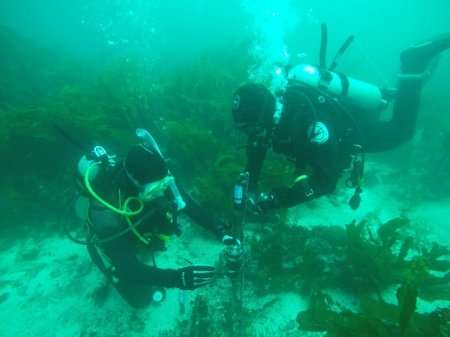Ship noise affects ability of marine species to communicate

University of Auckland scientists have carried out the first-ever large scale investigation into the effects of ship noise in the waters of the Hauraki Gulf.
The research shows a significant reduction in the amount of "communication space" available for at least two key marine species.
Ph.D. candidate Rosalyn Putland and Associate Professor Craig Radford from the Institute of Marine Science combined sound recordings from four hydrophone "listening stations" over a nine month period with automatic ship tracking data to track underwater noise contributed by shipping.
Suspended 1m to 2m above the seafloor, the hydrophones recorded two minutes of data every 20 minutes.
The study focused on two species which use sound to communicate, Bryde's whales (Balaenoptera edeni) and the common reef fish, bigeye (Pempheris adspersa).
It found noise from cargo, container and tanker vessels overlapped their vocalisations up to 20 percent of the time.
Every time a vessel passed within 10km of a listening station, it reduced communication space for bigeyes by up to 61.5 percent and by up to 87.4 percent for Bryde's whales. Research has shown bigeyes can communicate over distances of up to 31 metres, so a passing ship will reduce this to less than 12 metres.
The concept of "communication space" can be likened to the hubbub of a cocktail party where the ability to hear what is going on is reduced the louder the party becomes, says study co-author Associate Professor Craig Radford.
"Communication space is the range at which two species can hear each other and this study has found the range at which bigeyes and Bryde's whales can communicate is significantly reduced when a ship comes past."
The reduction of communication space for marine species is becoming an increasing concern for scientists worldwide as more is learned about how sound is used among groups of species to ensure survival including finding a mate, defending territory and warning of predators.
The biggest impact from ship noise was at Jellicoe Channel, the most regularly used shipping lane into Ports of Auckland where vessel passages were recorded 18.9 percent of the time.
This latest study provides further evidence that compliance with the 10-knot speed restriction within the Hauraki Gulf Marine Park area could benefit marine species, Rosalyn Putland says, as vessels travelling at lower speeds produce quieter levels of noise.
"The voluntary speed limit of 10 knots is fairly recent but we believe is having a significant effect on helping reduce noise in the Gulf to allow species to hear each other," she says.
"Even so, when a ship is directly above marine animals, it reduces communication for those animals almost completely, or by 99 percent," she says.
While this study focused on large commercial vessels, more than 130,000 recreational boats regularly use the Gulf and this number is expected to rise 40 percent in the next 20 years.
Recreational boats produce sound that also overlaps fish and marine mammal vocalisations. Further research at the Leigh Marine Laboratory will focus on how recreational boat noise in the Gulf affects the communication space of fish and marine mammals.
The study is published in Global Change Biology.
More information: Rosalyn L. Putland et al. Vessel noise cuts down communication space for vocalizing fish and marine mammals, Global Change Biology (2017). DOI: 10.1111/gcb.13996
Journal information: Global Change Biology
Provided by University of Auckland



















